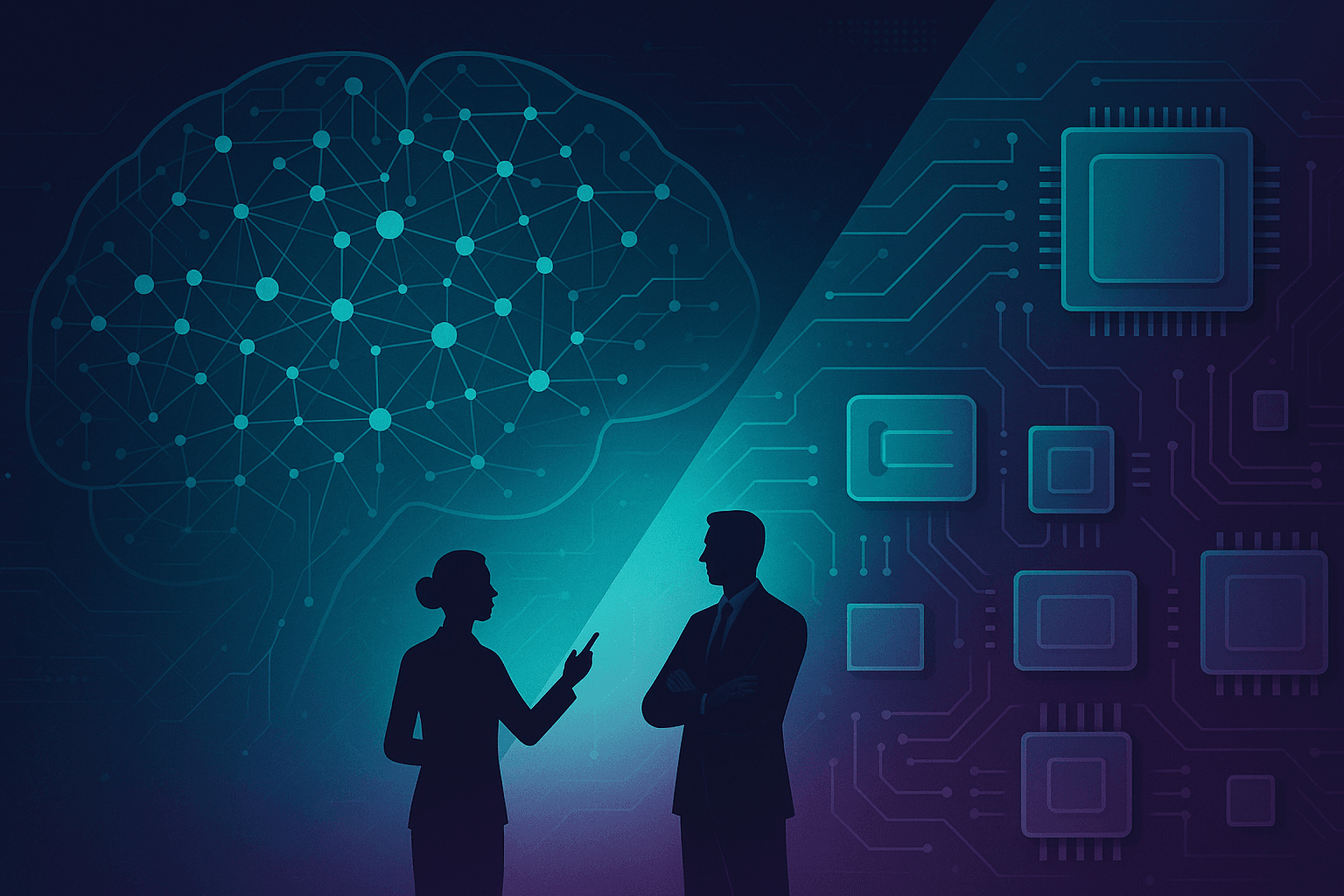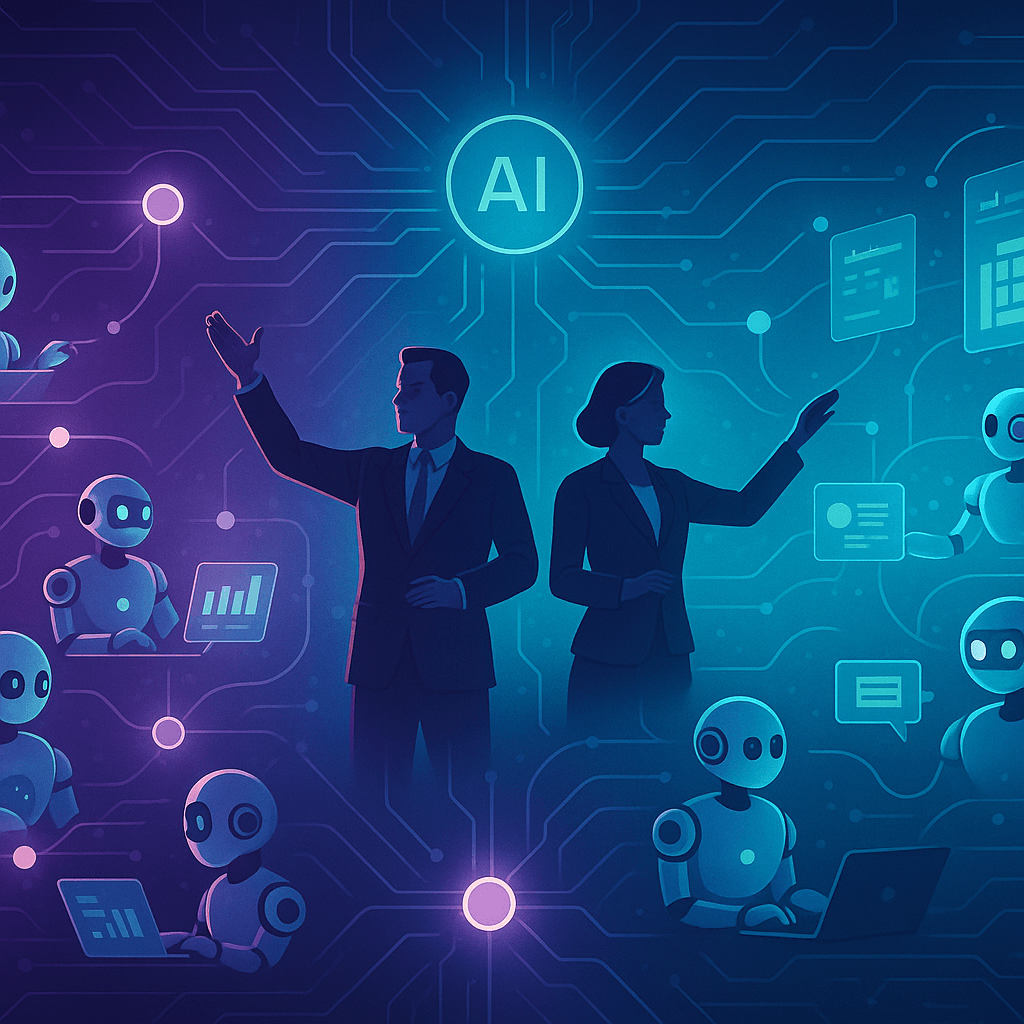LLMs vs. SLMs: Why the best AI model isn’t always the biggest
How the shift from scale to specialisation is reshaping both AI strategy and workforce demands.

The AI revolution is taking an unexpected turn. While tech giants compete to build ever-larger models, small language models (SLMs) are quietly becoming the real drivers of business performance. SLMs help companies deliver sharper customer experiences, unlock targeted innovation, and dramatically improve AI economics — all by being purpose-built rather than scaled for everything. This shift from generalist to specialist AI mirrors a fundamental transformation happening across the workforce itself.
The dominant logic of the frontier of generative AI development has been simple: scale equals intelligence. Since the introduction of the transformer architecture in 2017, model-development teams have added more data, more parameters and more compute to every new generation of models. For example, some early gen AI models contained about 340 million parameters, while some more recent models have hundreds of billions of parameters. Yet running routine business tasks on a billion-parameter model is like driving a Formula 1 race car to shop at the corner deli — both technically impressive and economically absurd. The same logic applies to AI. Large language models (LLMs) are powerful. They’re also very expensive to train and run. They demand massive computational resources. And they raise data-privacy concerns. Nevertheless, a recently released LLM by a Chinese startup highlighted how another path is viable. Because the model was trained on only a fraction of its parameters per token, graphics processing unit (GPU) usage was cut by more than 90% compared to conventional large-model baselines.
The result: The model’s costs for running everyday input-output tasks are 30 times lower, without compromising core language performance. While the model doesn’t support image generation or other multimodal features, its efficiency breakthroughs have changed the AI value equation. Indeed, after its release, the model quickly topped app store download charts, while wiping a trillion dollars off the equity valuations of rival tech firms. Still, cheaper LLMs are not the only reason why the AI value equation is being rewritten. And that other reason is smaller than many people realise.
This technological shift represents more than a strategic pivot — it’s fundamentally redefining what skills professionals need to thrive in the intelligent age. As organisations choose between AI approaches, the workforce must evolve from passive users to active AI orchestrators, capable of matching the right intelligence to specific business challenges and extracting maximum value from both human and machine capabilities.
TL;DR
- Small Language Models (SLMs) are quietly becoming the real business drivers — purpose-built intelligence outperforms massive generalist models for targeted tasks — Career shift: From AI user to AI orchestrator becomes the key professional differentiator.
- The economics are game-changing — SLMs run 30x cheaper while maintaining core performance, with 90% less power consumption — Strategic skill: Understanding AI model economics becomes essential for business credibility.
- New high-value roles emerging: AI Translators, Prompt Engineers, AI Ethics Officers bridging business needs with technical capabilities — Career opportunity: These hybrid roles command 40–60% salary premiums over traditional specialists.
- AI orchestration skills define the future workforce — knowing which AI tools solve which problems and how to combine them effectively — Critical competency: Success requires technical fluency without deep technical expertise.
- Multi-model strategies are reshaping enterprises — LLMs for complex reasoning, SLMs for targeted execution — Career advantage: Professionals who can navigate this complexity become organisationally invaluable.
- Speed and precision trump scale — specialised AI enables faster deployment and better enterprise alignment — Professional positioning: Master intelligent AI deployment now — the window for competitive advantage is narrowing as these skills become baseline expectations.
The rise of the small language models: Purpose-built intelligence
SLMs contain fewer than 10 billion parameters — often much fewer — yet deliver enterprise-ready performance that rivals their massive counterparts for targeted tasks. The secret lies not in scale, but in focus. Because SLMs require dramatically less data, compute and memory, they cost substantially less to train, deploy and maintain while being easier to fine-tune, faster to run, and better suited for embedding directly into business workflows.
SLMs fit where large models don’t on devices at the “edge,” as well as inside systems that demand speed, privacy and control. What SLMs lack in size, they make up for in relevance and precision. Techniques like Reinforcement Learning from Human Feedback (RLHF) further enhance their performance by aligning outputs with specific user expectations and enterprise contexts. To be sure, both LLMs and SLMs will continue to matter, but they’re built for very different jobs. Whereas LLMs function like general-purpose processors (flexible, powerful and built to do many things well), SLMs operate more like embedded controllers (lightweight, scoped and optimized for a single purpose). LLMs run your enterprise platform; SLMs run your smart thermostat. LLMs, in short, will still power frontier innovation. Yet SLMs will power everything else — efficiently, quietly and close to where business value is created.
Five key attributes make SLMs particularly valuable for enterprise deployment:
Cost-efficiency. As noted, SLMs require less infrastructure, less compute and less orchestration. Many run on a single GPU, reducing training costs by up to 75% and cutting operational expenses by more than half. For organisations constrained by capital or cloud dependencies, this opens the door to high-impact AI without hyperscale investment.
Speed and precision. Unlike general-purpose LLMs, SLMs can be fine-tuned for a single task or domain, reducing complexity and latency. Such fine tuning enables faster inference, which matters in real-time applications where every millisecond counts, such as chat interfaces, transaction processing and predictive diagnostics.
Strategic differentiation. SLMs allow companies to embed proprietary data, workflows and context — creating AI that mirrors business operations, rather than simplified abstractions. In contrast, generic, off-the-shelf models (large or small) can match performance but not nuance.
Energy efficiency. Many companies can’t run trillion-parameter models, especially at the edge. SLMs offer a sustainable alternative, reducing power consumption by up to 90%. This aligns with both environmental goals and the realities of deploying AI on mobile, internet of things (IoT) and disconnected devices.
Data privacy and sovereignty. SLMs can be deployed on-premises or at the edge, keeping sensitive information inside enterprise boundaries — an essential requirement for sectors like healthcare, finance and defence.
In other words, SLMs don’t just perform well. They often align better with enterprise needs, with constrained environments and with the reality that most business problems are narrow by design. That’s why the AI center of gravity is already shifting toward SLMs.
Moreover, as companies respond to today’s highly uncertain business environment, the appeal of SLMs will only grow. SLMs can boost operational resilience in multiple ways: they’re faster to deploy, more adaptable to industry-specific needs and more efficient to run in environments with limited computing resources. For example, after a Fortune 500 company deployed an SLM to support its internal supply-chain management system, employees could — with only a few simple prompts — find logistics and procurement data on demand; previously, the same workers needed to spend lots of time navigating complex dashboards. And when supply-chain volatility rose, the SLM was easy to retrain with real-time operational data. This, in turn, allowed the company’s supply-chain teams to identify delays and find alternative solutions much faster than before. This transformation — from complex system navigation to simple, conversational AI interaction — represents exactly the kind of skill evolution happening across industries as AI becomes more embedded in daily workflows.
As these real-world deployments demonstrate, SLMs aren’t just changing how companies implement AI — they’re reshaping the fundamental nature of human-AI collaboration in the workplace.
SLMs in action: The precision revolution
While a handful of AI firms continue scaling up foundation models, pursuing ever-broader capabilities and general-purpose intelligence, most enterprises are charting a fundamentally different path — one focused on precision, efficiency, and control. This divergence is reshaping how companies allocate AI resources. Rather than chasing generalist capabilities across every task, forward-thinking organisations are investing in smaller models fine-tuned for specific roles: HR assistants, service bots, diagnostic tools. These specialised models are faster to train, easier to govern, and better aligned to real-world business needs.
The goal: Use SLMs to simplify and streamline high-effort, low-value tasks (such as reconciliations and reporting) and enable more adaptive, context-aware operations (such as scenario-based planning and dynamic budgeting). The potential for similar breakthroughs is also high in sales and other business functions where fragmentation and manual effort remain high.
For instance, companies are deploying SLMs for routine but essential tasks like literature summarisation, survey coding, and compliance reporting, while experimenting with LLMs for higher-value activities such as strategic foresight modelling, cross-domain knowledge discovery, and complex scenario planning. Though these efforts have not yet yielded working prototypes, these emerging patterns signal a fundamental transformation in how organisations — and their workforce — will need to operate to maximise the benefits of AI at scale.
This strategic division of AI labour — assigning routine tasks to SLMs while reserving complex reasoning for LLMs — mirrors the broader workforce evolution where professionals must learn to orchestrate different types of intelligence for maximum impact.
The future of work in a multi-model world
The LLM vs. SLM divide is reshaping the very DNA of professional work, creating entirely new career landscapes and redefining what it means to be valuable in the modern workforce. As companies adopt hybrid AI strategies — using LLMs for complex reasoning and SLMs for targeted tasks — professionals must develop what we call “AI orchestration” skills: the ability to understand which AI tools solve which problems, and how to combine them effectively.
This shift is spawning new roles across industries. AI translators bridge the gap between business needs and technical capabilities, helping teams choose between a powerful LLM for strategic analysis or a focused SLM for routine automation. Prompt engineers design the interfaces that make AI tools accessible to domain experts. AI ethics officers ensure responsible deployment as models become more specialised and embedded in business processes.
These emerging roles represent just the beginning — as AI becomes more specialised and pervasive, we can expect entirely new categories of human-AI collaboration expertise to emerge.
But the transformation goes deeper than new job titles. Traditional roles are evolving in fundamental ways. Marketing professionals now need to understand which AI models best support real-time campaign optimization versus long-form content creation. Supply chain managers must know when to deploy SLMs for instant inventory alerts versus LLMs for complex scenario planning across multiple variables. HR leaders need to grasp how different AI architectures can transform talent acquisition, performance evaluation, and workforce development strategies.
The professionals who will thrive aren’t necessarily those who become AI experts — they’re those who become fluent in AI collaboration. They understand their organisation’s unique AI ecosystem, can identify opportunities for AI augmentation in their domain, and know how to shape AI outputs to drive business value. This represents a fundamental shift from traditional technical literacy to what we might call “AI fluency” — the ability to work with intelligent systems as collaborative partners rather than mere tools.
In this rapidly evolving landscape, the most successful professionals will be those who can continuously adapt their AI collaboration skills as new models and capabilities emerge.
Strategic Imperatives for the AI-First Enterprise
1. Start with clear objectives. Anchor AI investments in business outcomes, such as improving customer experience, automating operational processes or accelerating supply-chain decisions.
2. Measure success by impact, not model type. Remember that the model is the tool, not the outcome.
3. Track the AI landscape actively. The model ecosystem is shifting too fast for static strategies — and this rapid evolution demands equally agile workforce development to keep pace with emerging capabilities.
4. Build for modularity. Design AI infrastructure that can integrate new models without friction and shift away from vendor lock-in.
5. Strengthen infrastructure. A scalable AI strategy depends on establishing a resilient foundation: clean data, integrated systems and strong governance.
6. Explore IoT and edge. In environments where latency, privacy or infrastructure are constraints, SLMs offer a deployable, lightweight solution.
7. Strengthen your AI workforce capabilities. The shift to specialised AI models demands specialised human skills. Invest in developing AI literacy across your organization, focusing on practical competencies like prompt engineering, AI output evaluation, and model selection. Create pathways for employees to develop both broad AI awareness and deep domain-specific AI applications. This investment in human capabilities often determines whether AI implementations succeed or fail.
8. Build adaptive learning systems. As AI capabilities evolve rapidly, your workforce must evolve with them. Establish continuous learning frameworks that help employees stay current with emerging AI tools and techniques. This includes not just technical training, but developing the strategic thinking skills needed to evaluate new AI solutions, integrate them into existing workflows, and continuously identify new opportunities for AI-driven value creation.
These strategic imperatives reveal a deeper transformation: the fundamental reshaping of how professionals work, learn, and create value in an AI-driven economy. Success in this new landscape requires more than just deploying the right models — it demands building organisations and careers that can continuously evolve with AI’s rapid advancement.
Orchestrating Intelligence: The human advantage
The future of AI won’t be a choice between large and small models — it will be about intelligent orchestration. LLMs will power complex, multi-domain reasoning. SLMs will run on the edge, on-device, and inside systems where latency, privacy, or infrastructure are constraints. But the critical factor determining success won’t be the models themselves — it will be the humans who know how to deploy the right intelligence in the right context.
This creates unprecedented opportunities for professionals who can navigate AI complexity with strategic insight. Those who understand not just what AI can do, but when and how to apply different AI capabilities, will become invaluable as organizations race to implement AI at scale.
The workforce of the future will be defined by AI orchestration skills: the ability to combine human judgment with machine intelligence, to choose the right tool for each task, and to continuously adapt as new AI capabilities emerge.
In this landscape, the most successful professionals won’t be those who fear AI displacement — they’ll be those who master AI collaboration. The question is: how do you develop these orchestration skills and stay ahead of the rapidly evolving AI landscape?
Navigate the AI Transformation with Confidence
The rapid evolution of AI — from massive LLMs to specialised SLMs and everything in between — is creating both unprecedented opportunities and complex challenges for professionals and organisations alike. Understanding these technological shifts is just the beginning; the real competitive advantage lies in developing the skills, insights, and strategic thinking needed to thrive in this new landscape — and doing so faster than the competition.
At Ascend, we’re building the definitive platform for career navigation in the intelligent age. Our AI-powered ecosystem combines real-time market pulse insights, personalised skills mapping, and strategic foresight to help professionals and organisations stay ahead of technological disruption. Whether you’re a career professional seeking to future-proof your expertise or an enterprise looking to build AI-ready talent capabilities, we provide the tools, community, and intelligence you need to succeed.
The AI landscape will continue evolving at breakneck speed — but with the right platform and community, you can turn complexity into competitive advantage.
The future belongs to those who can orchestrate intelligence effectively.
Ready to master AI collaboration and accelerate your next career move? Connect with Ascend and discover how our platform can help you navigate the complexity of the AI transformation with confidence.
Sign up for early access 👉 www.ascendplatform.net


